6 Best Grass Seeds for Your Iowa Lawn
BY AMANDA SHIFFLER | JUNE 6TH, 2023 | IOWA, LAWN CAREChoosing the best grass seed for your Iowa lawn can be tricky. On some maps, the state lies just above the northern edge of what is considered the “transition zone” for growing grass, and some maps have the very southern border of Iowa within the transition zone boundary.
This can leave homeowners scratching their heads. Is it best to declare yourself a solid Midwesterner and grow cool-season grasses like the North, or should you approach your lawn like homes further south that are classified in the transition zone?
In this article:
- What is the Transition Zone?
- Cool-Season Or Warm-Season Grass?
- 6 Best Grasses for Iowa
- Considerations for Choosing a Type of Grass
- Choosing a Grass Seed Mix
- When to Plant Grass Seed
- FAQ
Understanding the Transition Zone
Before jumping headfirst into different grass types, it’s imperative to touch on the transition zone concept, so you understand why you may be facing some challenges when growing grass.
The continental United States is divided into different turf-growing regions based on annual average temperatures and relative humidity levels. It’s similar to USDA growing zones for your ornamental plants but also slightly different. These five regional classifications, though, help homeowners and landscapers decide what type of grass is best.
- “Cool/Humid” across the Pacific Northwest
- “Cool/Arid” spanning the Intermountain West and parts of the Great Plains
- “Cool/Humid” across the Midwest and Northeast
- “Warm/Humid” in the Southeast
- “Warm/Arid” in the Southwest
The area in the central part of the country where 4 of the five regions overlap is known as the transition zone. This 200-mile section runs from the Atlantic Coast to eastern New Mexico and encompasses a range of climates that see weather patterns of the North and South, where temperate and subtropical meet.
Growing grass in the transition zone can be difficult. There isn’t an ideal turfgrass adapted to the climate. Your winter weather may be too cold to maintain warm-season grasses, but warmer summers make it hard to grow cool-season turfgrasses. Unlike Goldilocks’ famed porridge, the temperate is never “just right” for one primary grass type.
Choosing whether to go with cool-season or warm-season grass is ultimately a personal decision. It’s helpful to contact your local county extension office for suggestions and talk to your friends and neighbors to see what they grow.
Understanding Cool-Season Versus Warm-Season Grasses
Now that you understand the transition zone better, let’s talk cool-season and warm-season grasses. Similar to how plants are classified as annuals or perennials, turf is known as cool-season or warm-season depending on how it grows and what climate it prefers.
Cool-season grasses grow across much of the northern part of the country. They are adapted to colder temperatures and can survive being buried under snow during the winter.
They’ll start greening up when temperatures climb into the low 40s and grow like crazy in the spring when soil and air temps are 65 to 75°F. They aren’t suited for the heat, though, and growth will slow down in the summer; they also need more water in July in August to stay green. When the temperatures dip again in the fall, they’ll grow vigorously until October or November, when they go dormant.
Common cool-season grasses:
- Annual ryegrass (Lolium multiflorum)
- Creeping bentgrass (Agrostis palustris)
- Creeping red fescue (Festuca rubra var. rubra)
- Kentucky bluegrass (Poa pratensis)
- Perennial ryegrass (Lolium perenne)
- Tall fescue (Festuca arundinacea)
On the other hand, warm-season grasses are better adapted to the summer heat experienced across southern climates. They thrive when temperatures soar (when they grow the most) and don’t need supplemental irrigation, but their growth falls off once the thermometer drops. They’ll go dormant much earlier in the fall than cool-season types.
Common warm-season grasses:
- Bahiagrass (Paspalum notatum)
- Bermuda grass (Cynodon dactylon)
- Buffalo grass (Buchloe dactyloides), carpetgrass (Axonopus affinis)
- Centipedegrass (Eremochloa ophiuroides)
- St. Augustine grass (Stenotaphrum secundatum)
- Zoysia grass (Zoysia japonica)
6 Best Turfgrasses for Iowa Landscaping
Kentucky Bluegrass (Poa pratensis)
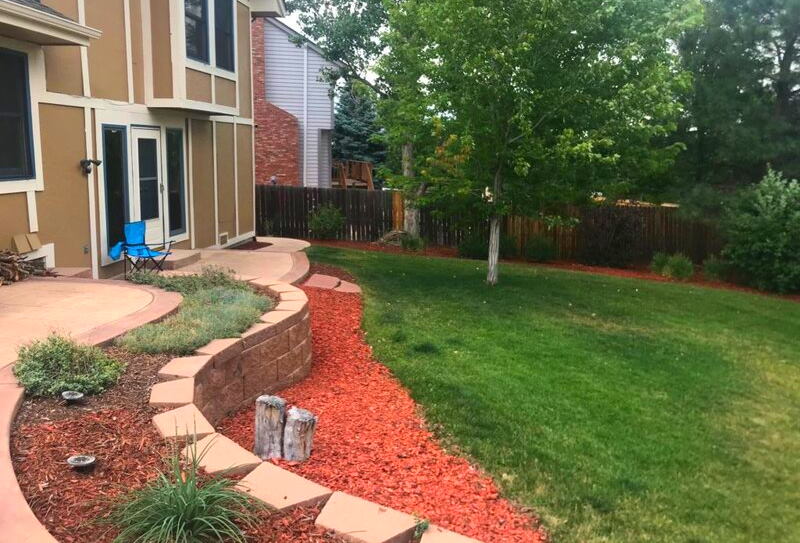
Photo Credit: Brenda Ryan / Wikilawn
Midwesterners love their Kentucky bluegrass (KBG), and it comes in as our number-one pick for homeowners in Iowa. KBG creates a dense, dark green turf blanket with exceptional winter hardiness.
Kentucky bluegrass is a cool-season grass that will grow in the sun to partial shade and handles foot traffic well since it spreads via rhizomes. This growth habit does make it slower to germinate and establish, but it’s a fantastic choice for yards with kids and pets.
The shorter root system on KGB makes it less heat tolerant than other turfs, especially warm-season grasses, so you must water it more to keep it green during Iowa summers. That being said, it also needs more frequent mowing and fertilization.
- Classification: Cool-season grass
- Color/Texture: Dark green, medium texture
- Shade Tolerance: Low to moderate
- Drought Tolerance: Moderate
- Foot Traffic Tolerance: Moderate (rhizomes help it recover well)
- Maintenance Needs: High
- Mowing Height: 2 ½ to 3 inches
- Spreads By: Rhizomes
- Potential for Disease: Moderate; susceptible to necrotic ring spot and summer patch
- Soil pH: 6 to 7.5
- Soil Type: Well-drained, highly fertile soils
Perennial Ryegrass (Lolium perenne)

Photo Credit: Dr Mary Gillham Archive Project / Flickr / CC BY 2.0
If you need to grow grass quickly, look no further than perennial ryegrass. It’s a cool-season bunchgrass known for its rapid germination (you’ll see sprouts in under a week) that helps this beautiful medium to dark green grass establish rapidly.
Perennial ryegrass has excellent foot traffic tolerance, making it a number one pick if you have kids or pets running around the yard often. The soft-to-the-touch blades also feel wonderful on bare feet! It will handle the abuse well, but be forewarned, that since it’s a bunchgrass, it can’t self-repair once it thins or becomes damaged. It is also pretty temperamental regarding the cold and may thin out when temps drop below 30°F for long periods.
- Classification: Cool-season grass
- Color/Texture: Dark green, fine texture
- Shade Tolerance: Moderate
- Drought Tolerance: Moderate
- Foot Traffic Tolerance: High, but low ability to recuperate,
- Maintenance Needs: Moderate
- Mowing Height: 1 ½ to 2 ½ inches
- Spreads By: Bunch-type grass
- Potential for Disease: Moderate; susceptible to gray leaf spot and rust
- Soil pH: 6.0 to 7.0
- Soil Type: Well-draining, highly fertile
Tall Fescue (Festuca arundinacea)
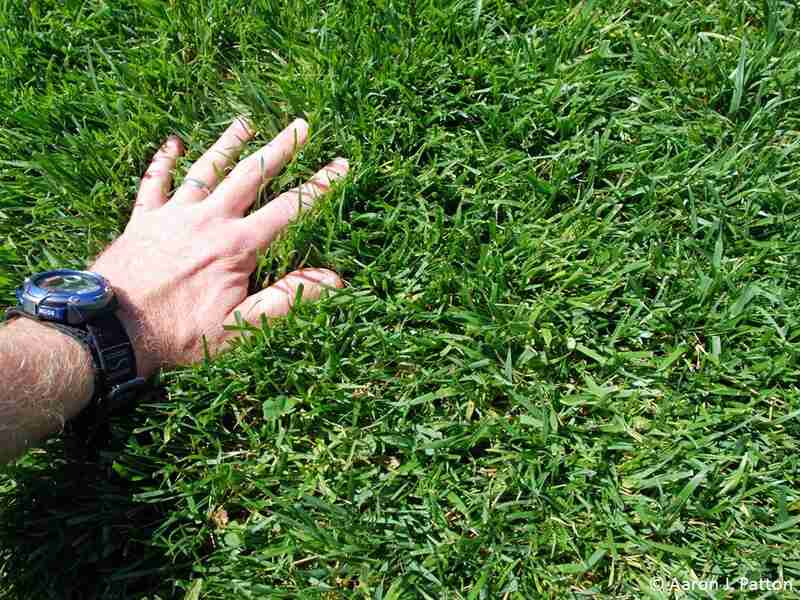
Photo Credit: Aaron Patton / Purdue’s Turfgrass Science Program
Tall fescue is a cool-season bunchgrass that grows in upright clumps and sends off vertical shoots at the bottom of each bunch. Since it propagates by these tillers, it continuously creates identical clumps of medium to dark green grass. Over time, these clumps grow in size (and spread) to fill in bare spots across the lawn, albeit slowly. Many people choose to reseed to help repair thin areas more quickly..
This grass does well in full sun and will handle partial shade as well, especially if it’s light to moderate afternoon shade. It sends down roots two to three feet into the ground, making it resilient about drought. If you want a low-maintenance lawn that doesn’t need irrigating, tall fescue is a great choice! Especially if your soil is slightly more acidic.
- Classification: Cool-season grass
- Color/Texture: Medium to dark green, coarse texture
- Shade Tolerance: Moderate
- Drought Tolerance: High
- Foot Traffic Tolerance: High, but doesn’t recover well
- Maintenance Needs: Low (but requires frequent mowing)
- Mowing Height: 3 ½ to 4 inches
- Spreads By: Bunch-type grass
- Potential for Disease: Low; susceptible to brown patch
- Soil pH: 5.5 to 6.5
- Soil Type: Fertile, well-draining clay soils
Bermudagrass (Cynodon dactylon)
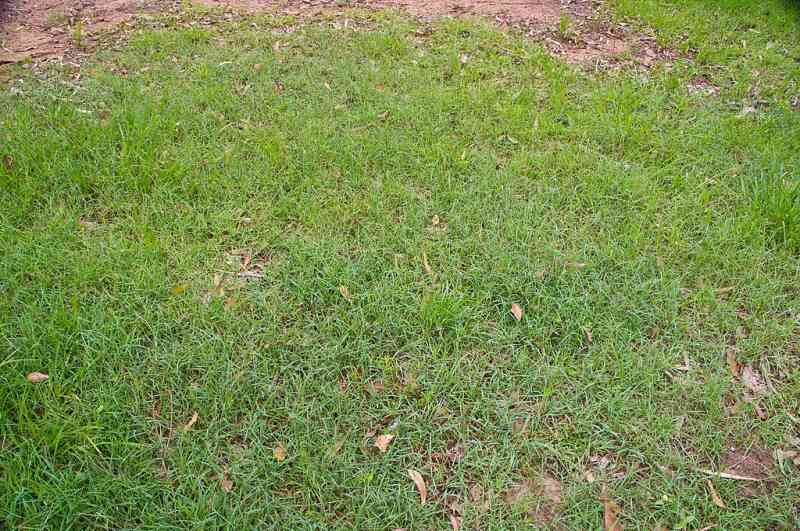
Photo Credit: John Robert McPherson / Wikimedia Commons / CC BY-SA 4.0
Coming in as the first warm-season turf species on our list, bermudagrass is a non-native plant commonly used in warmer climates to create beautiful lawns, athletic fields, and fairways. It holds up well to heavy foot traffic and quickly recovers.
When mowed once or twice a week, irrigated regularly, and fertilized a handful of times during the year, you can grow a stunning bermudagrass lawn. Many homeowners opt to cultivate an improved common variety instead of a hybrid species, as the improved common types require a little less routine maintenance. The common variety does provide a slightly lower quality lawn, compared to the hybrids that are finer textured.
- Classification: Warm-season grass
- Color/Texture: Light green to gray/silver green
- Shade Tolerance: Poor
- Drought Tolerance: High
- Foot Traffic Tolerance: High
- Maintenance Needs: High
- Mowing Height: ½ to 2 ½ inches
- Spreads By: Below-ground rhizomes and above-ground stolons
- Potential for Disease: Moderate to High
- Soil pH: 6 to 6.5
- Soil Type: Well-draining, fertile soil
Zoysiagrass (Zoysia japonica)
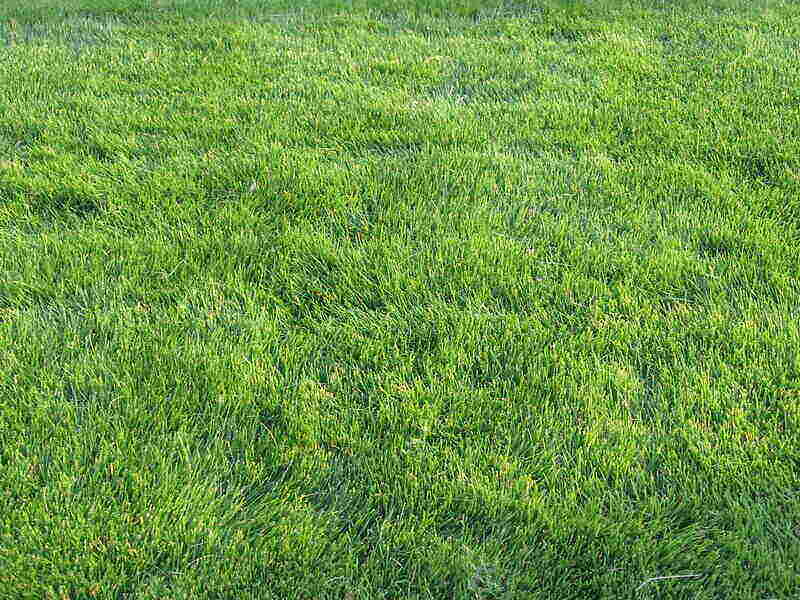
Photo Credit: Russbach at the English Wikipedia / Wikimedia Commons / CC BY-SA 3.0
Zoysiagrass is a good warm-season grass for the transition zone because of its cold tolerance. Of all the grasses for warm climates, it can handle the lowest temperatures with the fewest adverse effects. It also handles some shade and a fair amount of foot traffic. Zoysia japonica is one of two widely grown Zoysia species in the United States.
The coarse-textured, light green grass is slow to germinate and establish, so it is often started by plugs or laying sod instead of seeding. But it does love the summer heat and will grow vigorously when temperatures are hot to produce a dense, attractive lawn.
One of the most significant drawbacks to growing Zoysia is its need to be dethatched or power-raked every year or two. It develops thatch quickly, and when left on the soil surface, this layer of debris can increase disease and insect problems and may prevent water, nutrients, and air from moving down into the root zone.
- Classification: Warm-season grass
- Color/Texture: Light green
- Shade Tolerance: Moderate
- Drought Tolerance: High
- Foot Traffic Tolerance: High
- Maintenance Needs: High
- Mowing Height: 1 to 2 inches
- Spreads By: Rhizomes and stolons
- Potential for Disease: Moderate
- Soil pH: 6.0 to 6.5
- Soil Type: Various, as long as it doesn’t drain too quickly or hold onto too much water
Buffalograss (Bouteloua dactyloides)
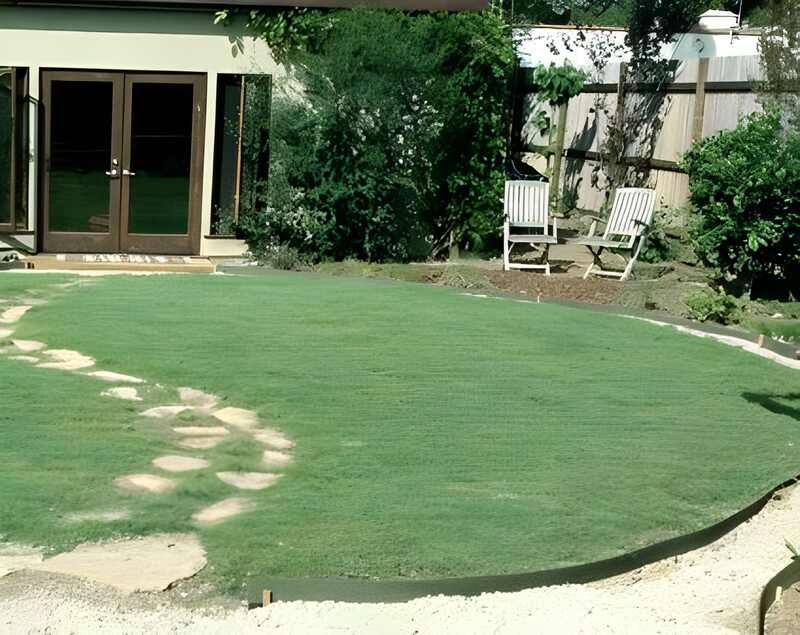
Photo Credit: Susan Harris / Flickr / CC BY 2.0
Coming in as our honorable mention, buffalograss is a warm-season grass species that is often used as a turfgrass. This native US species has been historically used for pastures and grazing, but its low-maintenance needs make it popular with homeowners looking for an easy-to-care-for lawn. While a warm-season turf, it has good drought tolerance and better cold resistance than some others.
Buffalograss is a fantastic choice if you’re looking for a sustainable lawn option with a traditional turf aesthetic. The finely textured perennial grass is one of the few native prairie grasses that forms a soft, dense sod that creates a suitable lawn with minimal mowing.
Growth will slow a bit if you’re trying to grow it in a shady location, and it will start entering dormancy as soon as the first autumn frost hits.
- Classification: Warm-season grass
- Color/Texture: Gray-green to yellow-green
- Shade Tolerance: Low
- Drought Tolerance: High
- Foot Traffic Tolerance: Low
- Maintenance Needs: Low fertilizer and mowing needs. Develops thatch and requires weed control.
- Mowing Height: 2 to 3 inches
- Spreads By: Stolons
- Potential for Disease: Good tolerance against diseases and insects
- Soil pH: 6.5 to 7.5
- Soil Type: Native clay soils, not sandy soils
Considerations When Choosing Turfgrass
There’s no doubt you have plenty of options to choose from in terms of grasses for your Iowa lawn. The most important part when picking a turfgrass is to find something that thrives in your yard. With this in mind, make sure to consider the three main things.
- Sun Exposure
- Foot Traffic
- Maintenance Requirements
How much sun does your yard get?
First and foremost, this should be the most critical consideration. You have to match your turf to your yard’s sun exposure.
If you have a yard that gets plenty of sunlight all day and isn’t shaded by your neighbor’s house or large trees, opt for Kentucky bluegrass, perennial ryegrass, bermudagrass, or buffalograss that love full sun.
If your yard is shaded by a privacy fence or a large apartment building next door, you’ll want to go with tall fescue since it is happy to grow in the shade.
Stick with zoysia or tall fescue if your yard mixes sun and shade.
Is your yard a raceway, or is there minimal foot traffic?
Matching the activity in your yard to how it handles foot traffic is also essential. If you always have dogs or kids running through the grass, you’ll want cool-season perennial ryegrass, tall fescue (or a blend with either), warm-season bermudagrass, and zoysia.
If foot traffic isn’t a concern, you should stick with Kentucky bluegrass or buffalograss, which doesn’t stand up well to frequent activity.
What are your availability and desire?
Let’s also be honest about how much time and energy you will put into keeping your lawn looking good. For people that like mowing, weeding, and fertilizing, you’ll be rewarded with a phenomenal yard if you choose Kentucky bluegrass, perennial ryegrass, Bermuda, or zoysiagrass. However, if you’d rather do anything besides mowing, you will be best off planting lower-maintenance buffalograss or tall fescue.
What About Planting Grass Seed Mixes?
Homeowners across the Midwest (and other parts of the country) often grow lawns containing a blend of different turf types. The genetic diversity of two or three grass types is fantastic if your yard is a mix of shade and sun because you’ll benefit from the different species. You’ll often see better disease, insect, and drought resistance.
The problem, though, is that you are severely limited when buying warm-season grass blends. It’s not uncommon to find a mix of Bermudagrass cultivars but not a blend containing Bermudagrass, Centipedegrass, and St. Augustine grass.
Since there’s such a marked difference in the traits—color, shade tolerance, watering needs—of the different warm-season grasses, they typically aren’t blended.
Whatever you do, don’t try to get fancy and blend warm-season and cool-season grass types. You’ll likely end up with a lawn that has patches of different textures and colors.
When Should I Plant My Iowa Lawn?
The goal of seeding a new lawn or overseeing your established yard is to throw seed down just before the grass usually kicks growth into high gear for the season.
Pro Tip: Cool-season grasses are best seeded between August 15 and October 1. They’ll have about six weeks to grow before the first fall frost. Warm-season grasses are best planted between April 15 and June 10. They’ll germinate and have a few weeks of solid growth before it gets hot.
These timelines aren’t set in stone. They’re just the recommended dates for best germination and optimal establishment.
- Cool-season grasses can be planted in the spring if the soil is warm enough. But it’s important to understand these grasses tolerate cold temperatures much better than the heat. So your seeds will do better going into fall dormancy just after germinating versus heading into summer heat just after sprouting.
- Warm-season grasses like heat more than cold, so you’ll want to get them down earlier in the year. You can plant in the fall, but give grass at least 6 to 8 weeks to establish before temperatures drop.
FAQ
When you plant depends on your regional climate and the turfgrass type you’re growing. It’s best to plant cool-season grasses in the fall in northern regions. You want to wait for hot summer temperatures to subside, but give the grass time to establish before the first fall frost. In the south, the best time to plant warm-season turfgrasses is in late spring or early summer, just as the temperatures begin warming up. In the transition zone, you sow based on the type of grass you’re growing.
Warm-season turfgrasses need hot summer temperatures and mild winters without snow; they grow mainly in the southern United States. Cool-season grasses need more temperate summer conditions but can survive harsh winters; they grow primarily in the northern United States. Both types will grow in the transition zone, but the mixed climate presents some challenges.
Ideally, you want to get cool-season grass seed down at least six weeks before your area’s first anticipated hard freeze. Your grass then has about a month to establish roots and prepare itself before it goes dormant. It’s similar for warm-season grass types, but they’ll do better planted earlier in the fall.
Remember that warm-season grasses stop growing once temperatures are below 55°F, and cool-season grasses won’t grow if temperatures are below 40 or 42°F. If you don’t hit that cutoff, you’ll have lackluster growth, and your grass might not be robust enough to survive the winter.
Need More Help With Your Iowa Lawn?
Being stuck in the middle is never fun, which certainly applies to homeowners bordering the transition zone’s edge. It can be tricky enough to establish a new lawn or reseed one that’s struggling without the woes of whether to plant warm-season or cool-season grasses. Hopefully, this guide helps you make a decision that you feel confident about, and you’ll have a gorgeous new yard in no time.
But don’t fret if you’re still unsure! The WikiLawn experts want you to have a yard that makes your neighbors green with envy. If you need help choosing grass seed or finding highly-rated landscape professionals, we’re here to help!
Main Photo Credit: Bayliss Park in downtown Council Bluffs, Iowa / Smallbones / Wikimedia Commons / CC0